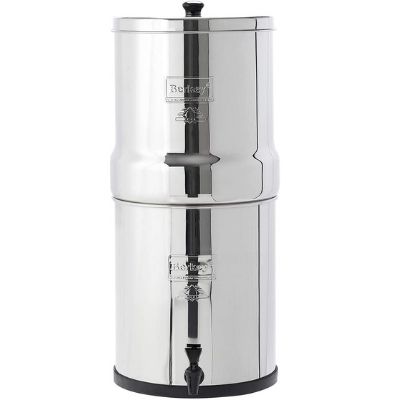
The Big Berkey is a stainless-steel gravity water purification system that removes 200+ contaminants. In our testing, the system greatly reduced or removed most of the contaminants we were concerned about. In test 1, we had issues with the Berkey PF2 fluoride filter elements leaching aluminum oxide (from the activated alumina media) into our water. This was almost completely resolved in our second test.
What We Like
What We Don’t Like
| Price | $447+ |
| Contaminants Removed | 200+ |
| Certifications | – Not Certified |
| Process | Carbon + Ion Exchange |
| Filtration Capacity | 3,000 gallons/cartridge |
| Annual Cost | ~$40 |
| Warranty | Lifetime |
Table of Contents
📊 Scoring Data
To obtain our scoring data, we conduct our own testing to evaluate a water filter’s performance, design, ease of use, and overall value for money. We also obtain data from company websites and third-party testing reports. In the table below, we’ve shared the data behind our scores for our different testing categories for the Big Berkey.
| Criteria | Results |
|---|---|
| Health Related Contaminants | 8.60 |
| Aesthetic Related Contaminants | 6.70 |
| Performance Certification | Not certified |
| Filtration Rate | 0.75 GPH |
| Component Quality | Excellent |
| Component Certification | Not certified |
| Setup | Failing |
| Servicing Requirements | Weak |
| Costs | $0.13/gallon |
| Company | Excellent |
🎬 Video Review
🚰 Contaminant Reduction
Score: 8.25We used SimpleLab’s Tap Score to test the Big Berkey and see which contaminants it could remove from our water. We then compared our data to Berkey’s contaminant reduction claims.
Our Performance Testing
SimpleLab sent us our test kit and the instructions we’d need to take our samples. We then shipped our samples to the lab to be professionally tested.
Tap Score has a strict sample-taking protocol that we followed to ensure our test results would be as reliable as possible. We started by priming all the filters following Berkey’s instructions, then installed them and performed a red dye test to ensure they were filtering correctly.
Next, we ran 50 gallons of water through the system to ensure the filters had already been used for a while before taking our samples. To take samples, we filled a clean bucket with water from our faucet and swirled it around to ensure it was well-mixed.
We poured most of the water from the bucket into the Big Berkey for filtration and dispensed our “after” sample of purified water from the Berkey spigot. We also took a sample of water directly from the bucket to be used as our “before” sample. A few days after sending our samples to the lab, we could view our interactive report on the SimpleLab website.

For reasons we’ll explain shortly, we tested the Berkey water filter system on two separate occasions. Below, we’ve discussed the contaminants detected in both tests, and how they compared.
Health-Related Contaminants
Score: 8.60
The Big Berkey is marketed for use with both treated and untreated water, so we tested its ability to remove contaminants from both city water and a river water source in Colorado.
In this category, our city water test results made up 50% of our scoring, and the other 50% was based on the river water test results.
For our city water testing, we used the Health Tap Score representing the quality of the water filtered by the Big Berkey, while for our river water testing, our priority was bacteria removal, so this is what we scored the Big Berkey on.
Test 1:
- Unfiltered water contained 12 contaminants with potential health effects, including chloroform, total THMs, bromodichloromethane, cobalt, and lead
- Post-filtration, Berkey effectively removed disinfection byproducts, lead, copper, & barium, & reduced cobalt by 3.33%
- Unexpectedly, the fluoride filters added aluminum oxide to the water
Test 2:
- Purchased new fluoride filters and followed instructions carefully, running over 100 gallons of water through filters
- Filtered water showed a 32% increase in aluminum levels from unfiltered water but below the HGL
- PF2 filters successfully removed fluoride, and Black Berkey filters removed barium, chloroform, copper, lead, manganese, and total THMs at 100%
| Test | Parameter | Type | Measurement | Pre-Filtration | Post-Filtration | % Change |
|---|---|---|---|---|---|---|
| 1 | Aluminum | Metals | PPM | 0 | 1.44 | #DIV/0! |
| 1 | Barium | Metals | PPM | 0.0317 | 0 | -100.00% |
| 1 | Bromodichloromethane | Disinfection Byproducts | PPB | 4.04 | 0 | -100.00% |
| 1 | Calcium | Minerals | PPM | 32.2 | 0 | -100.00% |
| 1 | Chloride | Inorganics | PPM | ND | ND | #VALUE! |
| 1 | Chloroform | Disinfection Byproducts | PPB | 23 | 0 | -100.00% |
| 1 | Cobalt | Metals | PPM | 0.0031 | 0.003 | -3.23% |
| 1 | Copper | Metals | PPM | 0.255 | 0 | -100.00% |
| 1 | Fluoride | Inorganics | PPM | 0.2 | 0.1 | -50.00% |
| 1 | Iron | Metals | PPM | 0.1 | 0.03 | -70.00% |
| 1 | Lead | Metals | PPM | 0.0027 | 0 | -100.00% |
| 1 | Magnesium | Minerals | PPM | 8.92 | 0 | -100.00% |
| 1 | Manganese | Metals | PPM | 0.0014 | 0 | -100.00% |
| 1 | Potassium | Minerals | PPM | 1.86 | 13.1 | 604.30% |
| 1 | Sodium | Minerals | PPM | 12.6 | 12.6 | 0.00% |
| 1 | Strontium | Metals | PPM | 0.168 | 0 | -100.00% |
| 1 | Sulfate | Inorganics | PPM | 16.6 | 1.6 | -90.36% |
| 1 | Total Coliforms | Bacteria | CFU/100mL | 15 | 0 | -100.00% |
| 1 | Total THMs | Disinfection Byproducts | PPB | 27.04 | 0 | -100.00% |
| 2 | Aluminum | Metals | PPM | 0.052 | 0.069 | 32.69% |
| 2 | Barium | Metals | PPM | 0.0127 | 0 | -100.00% |
| 2 | Bromodichloromethane | Disinfection Byproducts | PPB | ND | ND | #VALUE! |
| 2 | Calcium | Minerals | PPM | 8.8 | 34.6 | 293.18% |
| 2 | Chloride | Inorganics | PPM | 6.9 | 8.7 | 26.09% |
| 2 | Chloroform | Disinfection Byproducts | PPB | 35.2 | 0 | -100.00% |
| 2 | Cobalt | Metals | PPM | ND | ND | #VALUE! |
| 2 | Copper | Metals | PPM | 0.0434 | 0 | -100.00% |
| 2 | Fluoride | Inorganics | PPM | 0.1 | 0 | -100.00% |
| 2 | Iron | Metals | PPM | ND | ND | #VALUE! |
| 2 | Lead | Metals | PPM | 0.0006 | 0 | -100.00% |
| 2 | Magnesium | Minerals | PPM | 2.19 | 9.88 | 351.14% |
| 2 | Manganese | Metals | PPM | 0.001 | 0 | -100.00% |
| 2 | Potassium | Minerals | PPM | 0 | 1.68 | #DIV/0! |
| 2 | Sodium | Minerals | PPM | 10.4 | 9.29 | -10.67% |
| 2 | Strontium | Metals | PPM | 0.062 | 0.138 | 122.58% |
| 2 | Sulfate | Inorganics | PPM | 10 | 23 | 130.00% |
| 2 | Total Coliforms | Bacteria | CFU/100mL | ND | ND | #VALUE! |
| 2 | Total THMs | Disinfection Byproducts | PPB | 35.2 | 0 | -100.00% |
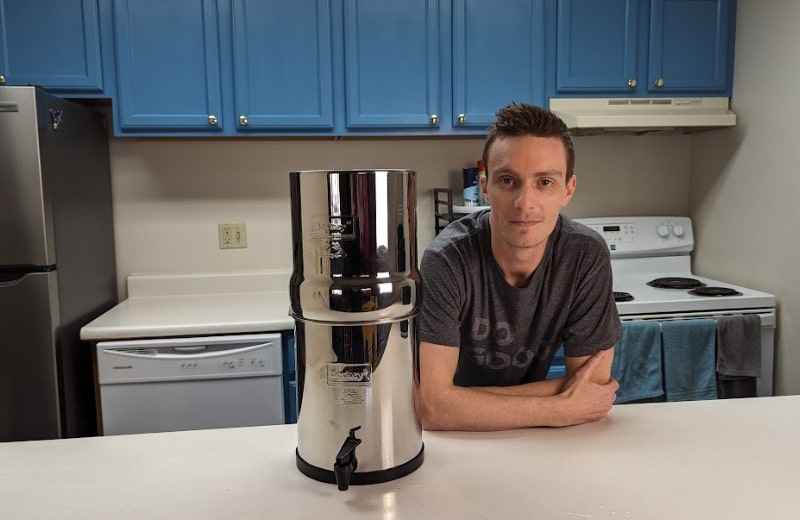
Test 1
In test 1, our unfiltered water contained 12 contaminants with potential health effects, with five of these – chloroform, total THMs, bromodichloromethane, cobalt, and lead – being detected in concentrations higher than the HGL.
Also present in lower trace amounts were copper, fluoride, strontium, sulfate, barium, manganese, and sodium. All these contaminants have several possible health concerns, including:
- Immune effects
- Nervous system problems
- Gastrointestinal effects
- Blood system issues
- Cardiovascular effects
- Kidney and liver problems
- Developmental and skeletal problems
- Reproductive effects
- Carcinogenic (cancer-causing) effects
In our post-filtration test results, we could see that the Berkey had done a great job at removing our water’s disinfection byproducts, lead, copper, barium, and manganese, and cobalt was reduced by only 3.33%.
However, our unfiltered water contained no aluminum – but the post-filtration test results detected 1.4 PPM of aluminum in our water. This is very concerning given that the official MCL set by the U.S. EPA for this contaminant is 0.2 PPM.
That meant the Berkey fluoride filters, which use activated alumina filtration media, were adding aluminum oxide from the media into our water. We couldn’t understand why this had happened – activated alumina shouldn’t leach like this, especially when used with neutral pH water (our water had a neutral pH of 7.5).
The PF2 filters also only reduced our water’s fluoride by 50%, from 0.2 to 0.1 PPM, but Berkey claims that it can remove up to 99.99% of this contaminant.
Something didn’t seem right, so we decided to conduct another water test to see if we’d received faulty fluoride filters or had done something wrong when installing the filters (despite following Berkey’s instructions in the user manual).
Test 2
For our test 2, we purchased a brand-new set of Berkey fluoride filters and carefully followed the priming and installation instructions, being particularly mindful not to make more than 8 rotations when screwing the filters in place.
We also ran more than 100 gallons of water through the filters – 50 more gallons than last time – before conducting the test.
This time, our filtered water’s aluminum levels were much lower, at 0.69 PPM – a 32% increase from the initial 0.52 PPM detected in the unfiltered water. Even with our additional preparation, the fluoride filters still added 0.069 PPM of aluminum oxide to the water, but this was at least lower than the HGL of 0.6 PPM. Also, the PF2 filters completely removed fluoride, which we were relieved to see, given that this was their intended purpose.
The Black Berkey filters also removed 100% barium, chloroform, copper, lead, manganese, and total THMs from our water.
Aesthetic Contaminants
Score: 6.70
Test 1:
- Unfiltered water had around 0.5 PPM of chlorine, which the Big Berkey removed
- Filtered water showed an elevated pH of 8.7, attributed to aluminum oxide from activated alumina filters
- Overall score was influenced negatively by the presence of aluminum oxide
Test 2:
- Big Berkey effectively removed chlorine
- No other contaminants detected in concentrations affecting aesthetics
- Post-filtration, the water’s pH decreased from 7.9 to 7.5
Test 1
In test 1, chlorine was detected in our unfiltered water. SimpleLab sent us a chlorine test strip so we could test our water’s chlorine levels pre- and post-filtration at home (we couldn’t get this tested at the lab since chlorine is volatile and dissipates quickly).
We had around 0.5 PPM of chlorine in our tap water, and our test results showed that the Big Berkey removed this completely. This is likely due to the use of activated carbon in the Black Berkey filters, which is the very best at taste and odor removal and is widely used in water treatment for this purpose.
However, the pH of our filtered water from the Big Berkey had shot up to 8.7, which, the test noted, could affect our water’s taste.
The test also listed aluminum (which, as we mentioned above, was the aluminum oxide that leached into our water from the activated alumina filters) as a likely source of water discoloration – but only in the presence of iron. This initial test strongly influenced the overall score we gave the Berkey for aesthetic contaminants (we combined the results from both tests).
Test 2:
In test 2, once again, the Big Berkey removed all the chlorine from our water.
No other contaminants were detected in high enough concentrations to have aesthetic effects in our pre-filtered water or our post-filtered water. Our water’s pH actually went down post-filtration, from 7.9 to 7.5 (still on the alkaline side of neutral).
River Water Test
In our river water testing, the Big Berkey eliminated total coliform (a type of bacteria that can be an indicator of harmful bacteria strains) from our source water.
We didn’t include these factors in our ranking, but there were a few other contaminants that the Berkey system also did a good job of reducing or removing, including iron (reduced from 0.1 to 0.03 PPM), and manganese (reduced to undetectable levels). But the system made no difference to our water’s aluminum levels (0.04 PPM).
Performance Certifications
Score: 6.00
The Black Berkey elements have been third-party tested by numerous labs for their ability to remove 200+ drinking water contaminants. The test results can be viewed online here.
Berkey originally claimed that its filters could remove microorganisms, but these claims have since been revoked.
Neither the Black Berkey water filters nor the PF2 fluoride filters hold any official performance certifications by the NSF/ANSI, IAPMO, or WQA.
So here, we’ve compared the Big Berkey’s contaminant removal data from our own testing with Berkey’s testing claims for these contaminants.
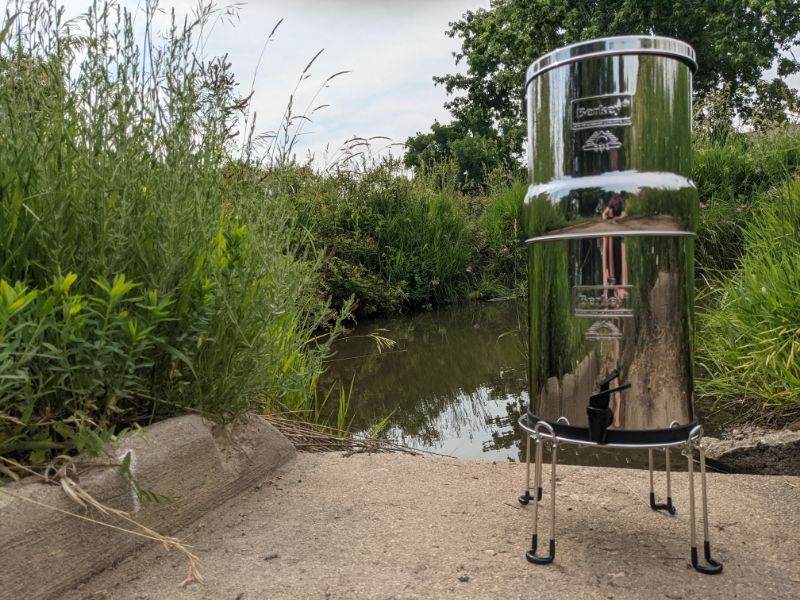
Berkey’s third-party test results show that it can remove up to 95% nitrate, 99% arsenic, 99.5% cadmium, 95% copper, 95% cobalt, 97.5% lead, 90% molybdenum, 95% barium, 85% total chlorine, 99.99% of numerous disinfection byproducts, chloramine, pesticides, pharmaceuticals, and more.
Not all these contaminants were present in our trace water, so we can’t validate Berkey’s claims across the board. But the Big Berkey did remove 100% of lead, chlorine, disinfection byproducts, copper, barium, and manganese from our water, and reduced cobalt by 3.33%, exceeding the removal percentages in the third-party test data.
The Black Berkey elements completely removed strontium and reduced sulfate by around 10%, which was a nice bonus given that we couldn’t find any third-party testing for these contaminants anyway.
Berkey’s test data also shows that the filters can reduce up to 75% aluminum. This wasn’t the case for us – we had aluminum oxide leaching from the PF2 activated alumina filtration media, although this wasn’t anywhere near as bad when we retested the fluoride filters. Still, aluminum didn’t decrease in our water when using the Berkey with the PF2 filters.
The fluoride filters have also been tested to remove fluoride down to less than 50 PPB (parts per billion) under optimum conditions. They reduced our water’s fluoride from 0.1 PPM to 0 PPM in our second test, which was exactly what we wanted to see.
Compare our test results with Berkey’s third-party testing data in the table below.
| Contaminants | Berkey’s Removal Claims (%) | WaterFilterGuru Testing Data |
|---|---|---|
| Lead | 97.50% | 100% |
| Chlorine | 85% | 100% |
| Disinfection Byproducts | 99.99% | 100% |
| Copper | 95% | 100% |
| Barium | 95% | 100% |
| Manganese | – | 100% |
| Cobalt | 95% | 3.33% |
| Strontium | 100% | 100% |
| Sulfate | – | 10% |
| Aluminum | 75% | +100% (test 1); +32% (test 2) |
| Fluoride | 50.00 | 100.00 |
🚦 Filtration Rate
Score: 7.50The Big Berkey was a let down when it came to filtration rate.
We know that gravity water filtration systems filter water at a slower, steadier rate, but with 2 black filters and 2 fluoride filters, we calculated that the unit was filtering our water at a rate of just 0.75 gallons per hour (GPH).
That’s worse than most other stainless steel countertop water filters we’ve tested, but we found that we needed to routinely clean our elements to ensure the flow rate continued to be acceptable.
Also, we also noted that priming the filters correctly directly influences their flow rate. If you don’t achieve a proper prime, the system filters significantly slower.
When we first set up the Berkey, we realized this was an issue because only one of the filter elements was filtering quickly. So we removed the one that wasn’t working well and re-primed it, which did the trick: it started filtering just as fast as the other. But that taught us the importance of following the priming procedure exactly – not doing so will affect the speed of filtration.
📐 Design
Score: 7.80There were a couple of scoring factors we used to assess the Big Berkey’s design: its component quality and whether or not it had any certifications for design safety.
The Berkey countertop water filter is sold in a few different sizes, from the smallest Travel Berkey, for 1-2 people, to the largest Crown Berkey, for 6-10 people. For our review, we went for the Big Berkey unit as the most popular choice, suitable for 2-4 people. This Berkey system is 19.25” tall and 8.5” – so it’s on the taller side for a countertop water filter.
Regardless of the size you choose, you’ll get a cylindrical countertop gravity water filter that holds up to 2.25 gallons of filtered water in the lower reservoir. It’s made from stainless steel, which is durable and BPA-free, although we’re personally not the biggest fans of the industrial silver steel look. Since the Berkey units don’t connect to electricity, they’re pretty minimalist in design.
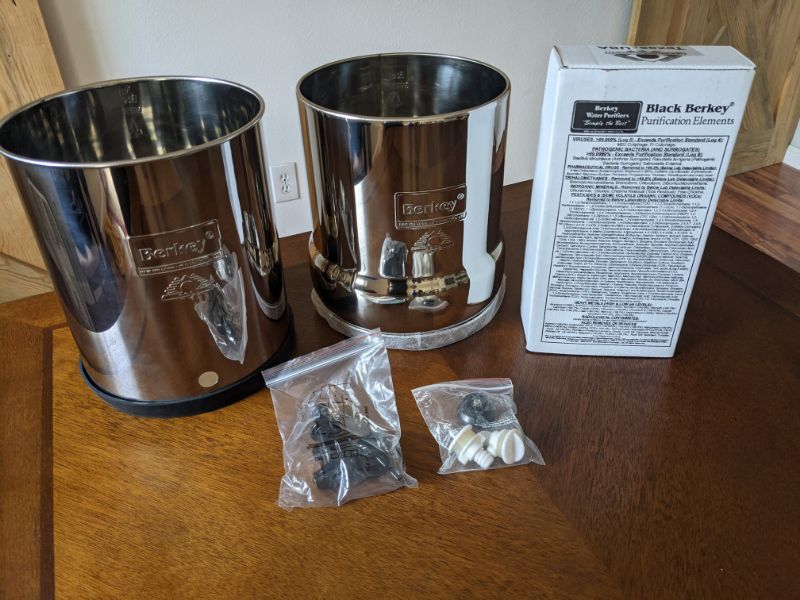
The Big Berkey isn’t anything special from the outside, but we were pleased with its practicality and functionality. It’s pretty big and bulky, but not offensively ugly, and it has all the basic and necessary features for a gravity countertop water filter.
Design Flaws & Setbacks
Like pretty much every stainless steel countertop water filter we’ve tested, the Berkey has a very specific design flaw.
The issue is that the filtration process continues even when the lower chamber is full, so we needed to be really careful not to overfill the system (we learned this the hard way, when water flowed out of the space between the two chambers and flooded our countertop).
Plus, we couldn’t see how much water was left in the bottom chamber. We had to lift the top chamber to look. Berkey sells a sight glass spigot to avoid this issue, but at an extra cost.
Component Quality
Score: 9.00
On the whole, we were pleased with the Berkey’s component quality. It’s made from 304 stainless steel, so it’s sturdy and not likely to shatter or fall apart after a few years of use.
The only issue we had was that the included spigot is plastic. Many of Berkey’s competitors sell their filtration systems with non-plastic spigots, but Berkey sells stainless steel spigots as add-ons – meaning you have to pay more upfront to avoid plastic in this component.
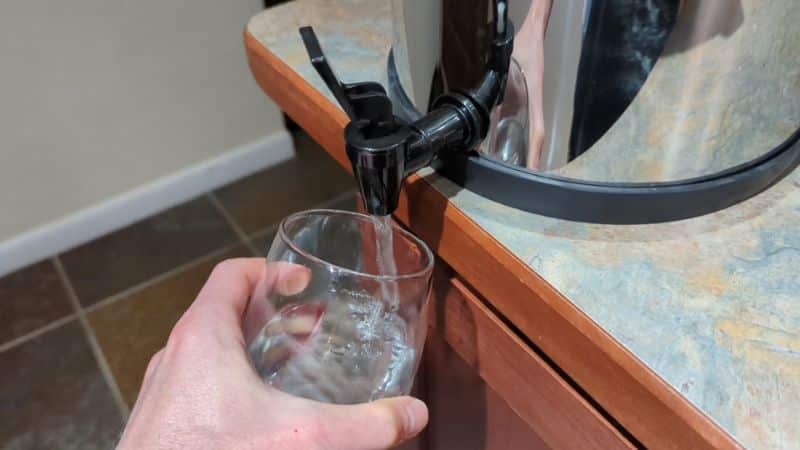
Design Longevity
304 stainless steel, the type of stainless steel used to make the Big Berkey, is resistant to corrosion, making it a good material for water storage. We couldn’t find any official sources that gave a definite lifespan for stainless steel, but manufacturers of this material generally say that it lasts 20-50 years or longer.
The Big Berkey shouldn’t rust, and we didn’t notice any rusting in the water chambers during our testing period. We found a few customer reviews that mentioned potential rust/oxidation, but we have no way to validate these claims because we found them on Amazon, and Amazon’s review system is easily manipulated.
Certification
Score: 6.00
In our research, we found no evidence that the Big Berkey or any other Berkey units have been certified for materials safety.
Filter Materials
The Black Berkey filters consist of activated carbon and five other types of media (only one of these is disclosed: ion exchange resin). We know that activated carbon is a proven effective filtration method for removing chlorine, pesticides, and other contaminants with health effects, according to various studies. Ion exchange is also a popular media choice for gravity filters.
Activated carbon and ion exchange water filter media are generally considered safe for use in water treatment devices because they’re non-toxic, and activated carbon is typically made from natural materials (for instance, the filter used in the Berkey unit is made from coconut shell carbon).
However, the filter housings and the nuts used to screw the filters onto the upper chamber are made of plastic, so we can’t say for certain that there’s no risk of microplastics or bisphenols leaching from the filters themselves.
We remain uncertain about the safety of the materials used in the activated alumina fluoride filters. Although much less aluminum oxide leached into our water in our second test, we still feel uncomfortable about how easy it was for this leaching to occur. But we may have received faulty filters in our initial testing.
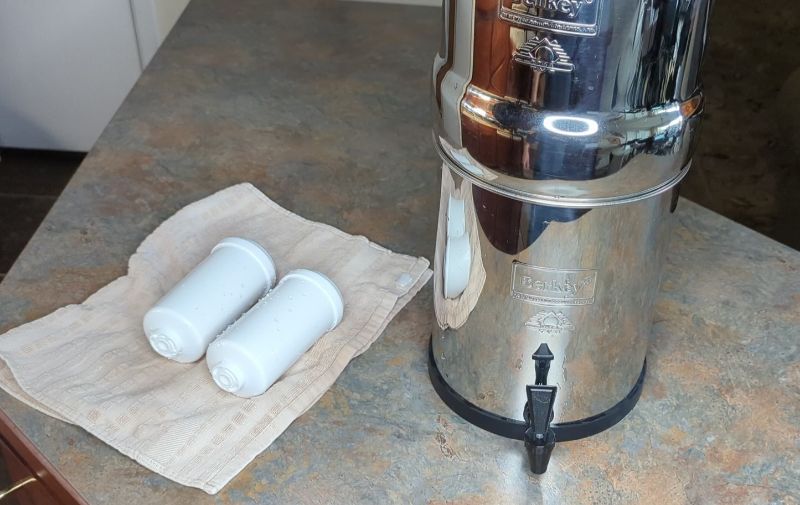
⚙️ Setup
Score: 6.50We awarded Berkey’s setup score based on how long it took us to get the unit ready for use out of the box.
We were disappointed with the setup process for the Big Berkey. Even though we didn’t need to have specialized knowledge for the setup, we found the filter priming to be tedious, extremely time-consuming, and annoying.
The filters were shipped to us without being primed by the manufacturer, so we had to do this ourselves. Priming all 4 filters took at least an hour, plus 20 minutes to set up the body of the unit (as outlined in the user manual).
There were a few specific grievances we had with the priming process: the tan priming washer was nearly impossible to get a seal with on the faucet, and the blue priming nipple only works well with older faucets. Neither method works well with modern faucets like pullout or spray handles.
We’ve had much better experiences with competitors – some sent us pre-primed filters, while others had a simpler priming process, like filtering and discarding several batches of water through the unit, which takes a while but is at least easy.
There’s also a separate document on the fluoride filter priming process, so we weren’t even finished once we’d primed the Black Berkey elements. The instructions are very specific, essential to follow, and easy to slip up on – for example, the note for screwing the PF2 filters onto the Black Berkey elements: do not screw on more than eight revolutions as this may damage the internal media screen.
We’ve shared a guide on how to prime the Berkey filters for reference.
🔧 Maintenance
Score: 8.5We also assessed the Big Berkey’s servicing requirements and the long-term costs of the filters.
Servicing Requirements
Score: 7.00
We didn’t find the process of replacing the Berkey elements difficult, but the filter replacements require priming, which is a huge pain.
Berkey also has cleaning instructions for the system, which includes cleaning the stainless steel chambers once every month, and cleaning the Black Berkey filters using a Scotch Brite pad every 3-6 months, or when they start to filter water slowly. This is also a bit annoying, but it meant we were extending the filter lifespan and could avoid the priming process for as long as possible, so we had a big motivation to do it.
Check out our guide on cleaning the Berkey filters if you want to know what it involves.
Aside from filter changes, we washed out the top and bottom chambers, which is easy if not a bit fiddly if you have a relatively small kitchen sink like us.
Costs
Score: 10.00
We calculated the cost per gallon of the filters in the Berkey system to determine the system’s value for money over the long run.
The cost per gallon overall for both Berkey filters is $0.13/gallon. Here’s a breakdown of the cost per gallon for each filter type:
- Black Filters (with a lifespan of up to 6000 gallons for a pair – Berkey filters are sold in at least twos): $0.034/gallon
- White Fluoride Filters: $0.09/gallon
The Big Berkey’s ongoing spend is super cheap, but that’s if we’re to believe that the Black Berkey elements really do last up to 6,000 gallons (most competitors’ filters only last a few hundred gallons at most). We’ll report back when we replace our set of filters to let you know how long ours lasted.
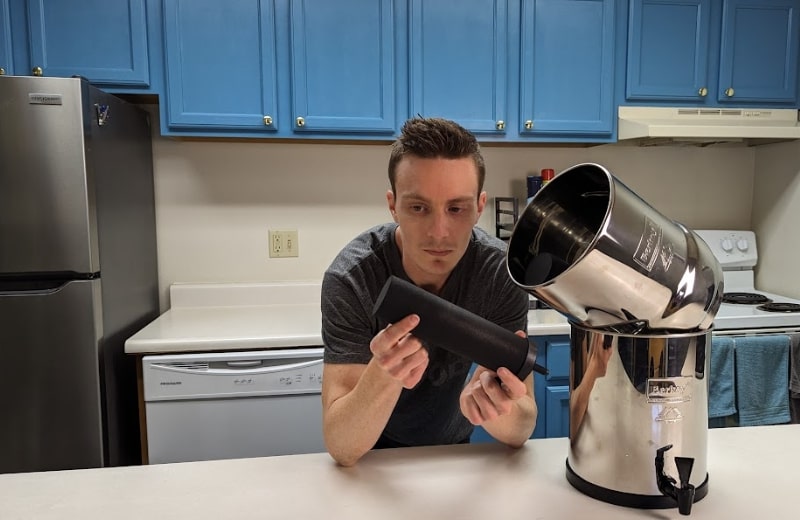
🏢 Company
Score: 9.10To assess Berkey as a company, we looked at the warranty period, shipping, and returns for Berkey products.
Berkey water filters aren’t sold directly by the manufacturer; instead, there are lots of Berkey distributors that sell Berkey products. We’ve evaluated the offerings by BigBerkeyWaterFilters.com, one of the biggest Berkey distributors we found.
Warranty
Score: 10.00
BigBerkeyWaterFilters.com offers a lifetime warranty for Berkey systems, meaning that they’ll replace any parts that come as standard with the system throughout the customer’s lifetime of ownership.
That’s as good as we could ask for in this category, although the customer is responsible for processing and shipping fees. You can view the warranty terms here.
Shipping
Score: 9.00
If you spend over $99 and live in one of the lower 48 states, you’ll get free shipping when you ship with BigBerkeyWaterFilters.com.
Most Berkey products, including replacement filters, cost over $99, so it’s likely that you’ll get free shipping.
There’s a shipping fee for customers in Canada. International shipping to other regions is currently paused.
View Berkey’s shipping policy here.
Learn about restrictions & how to get a Berkey in California here
Returns
Score: 8.00
BigBerkeyWaterFilters.com offers a 30-day returns policy, entitling customers to a 100% refund within the initial 30-day period after purchase. That’s pretty good, although not the longest we’ve seen – some manufacturers offer 90-day or longer returns policies.
Find more information on Berkey’s returns policy here.
Found this review helpful?
Comment below or share this article!

